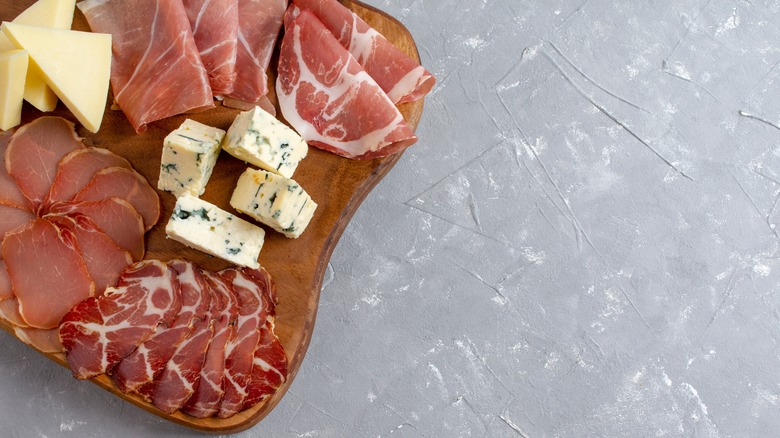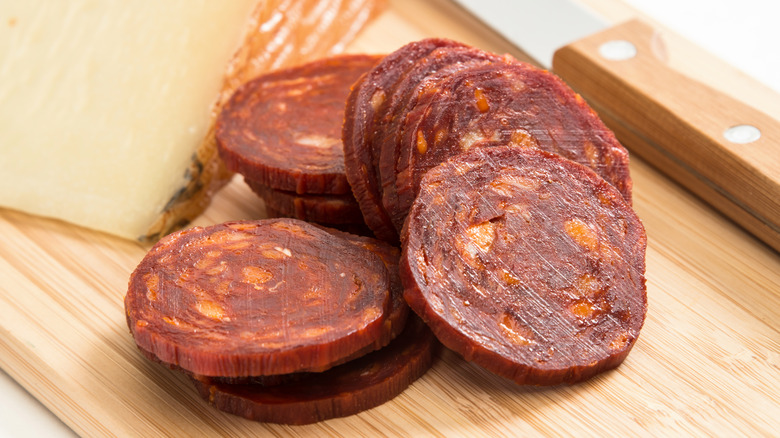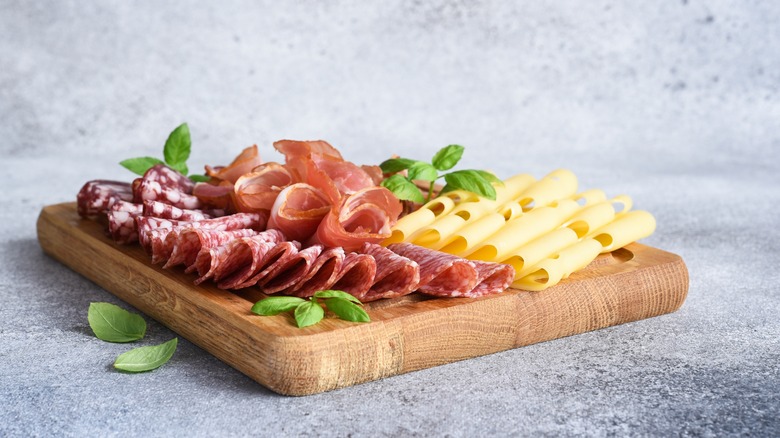What To Keep In Mind For The Perfect Cured Meat And Cheese Pairing
There's nothing like a good charcuterie board. Whether you're snacking on it at midday, enjoying it as an appetizer, or simply eating it in place of a meal, a mix of cheese and cured meats and accouterments always hits the spot. But there's an art to crafting the perfect cheese and meat board that's more complex than reaching for whatever's in front of you at the grocery store.
There are some basic rules to meat and cheese pairings that will take your next charcuterie board to the next level. When it comes to pairing anything culinary, you have two options: pairing similar flavors and textures together or pairing opposing flavors and textures. With cheese, opposites tend to attract; we recommend seeking balance between cheeses and meats that offer opposing flavor profiles and mouthfeel, such as salty paired with sweet, or hard with soft. Take this approach, and you'll have a delicious combination of options on your charcuterie platter every time.
Cheeses for sausages and encased meats
There are two main "types" of meats that find their way onto charcuterie boards: encased meats, such as sausages, and "whole-muscle meats," such as prosciutto, bresaola, and coppa. Encased meats tend to be saltier, spicier (especially in the case of heavily-seasoned sausages, such as chorizo), and firmer in texture than their whole-muscle counterparts and are often mixed with extra ingredients, such as garlic or pepper.
Encased meats pair excellently with cheeses. However, it's important to select pairings that don't feature competing flavors, or the taste may get muddled in the process. As a rule of thumb, choose a softer, milkier cheese to pair with encased meats, such as a chevre, ricotta, or even a triple-creme Brie.
These spreadable cheeses pair excellently with the firmness of smoked or cured sausages. Their creamy, mild texture and taste also offset any strong spiciness or saltiness from the meat, bringing balance to the combination.
Whole muscle meats and cheeses
Whole-muscle meats are exactly what it says on the tin: meats that use the whole muscle of the animal without chopping, grinding, or otherwise processing it beyond slicing it off the bone. Prosciutto, which is carved off the leg of a pig, falls into this category; these meats are typically soft, fatty, buttery, and even a little gamey. They'll pair well with harder cheeses that have a little bit of backbone to them, texture-wise, as well as cheeses that have a touch of an acidic bite, which can offset the gaminess of the meats.
Try an aged, hard cheese, such as Parmigiano Reggiano, for a softer meat, such as prosciutto (especially if you're serving prosciutto di Parma, which comes from the same region of Italy as Parmesan). Speck, with its slightly smoky flavor, goes well with the nuttiness of an Asiago or a Comté.
However, there are exceptions to the rule. At times, you can also pair these whole muscle meats with softer cheeses, as with bresaola, whose delicate sweetness pairs best with something soft and mild, such as burrata.


